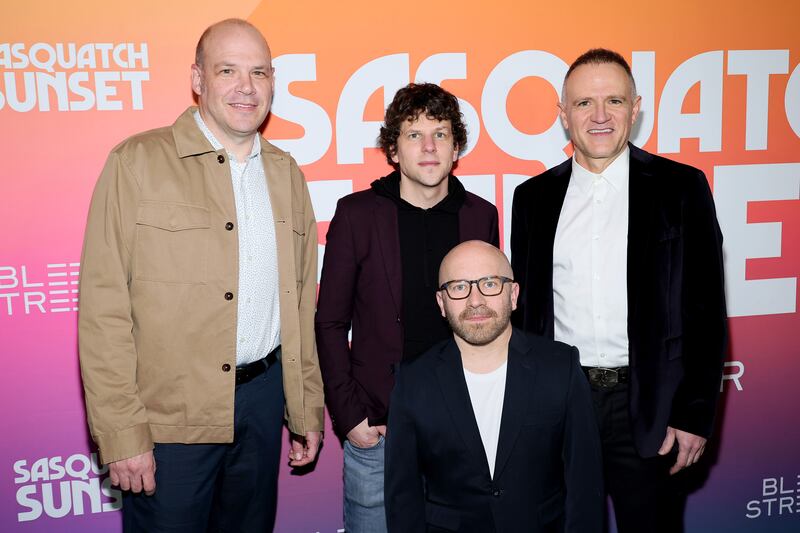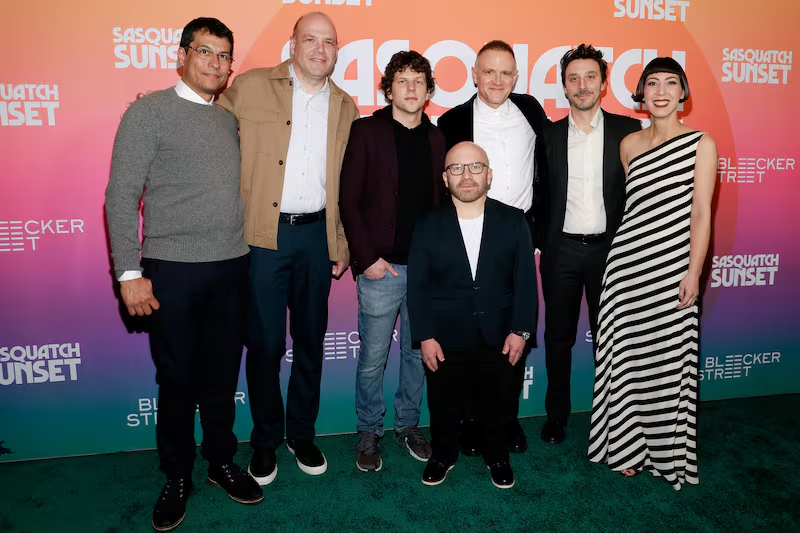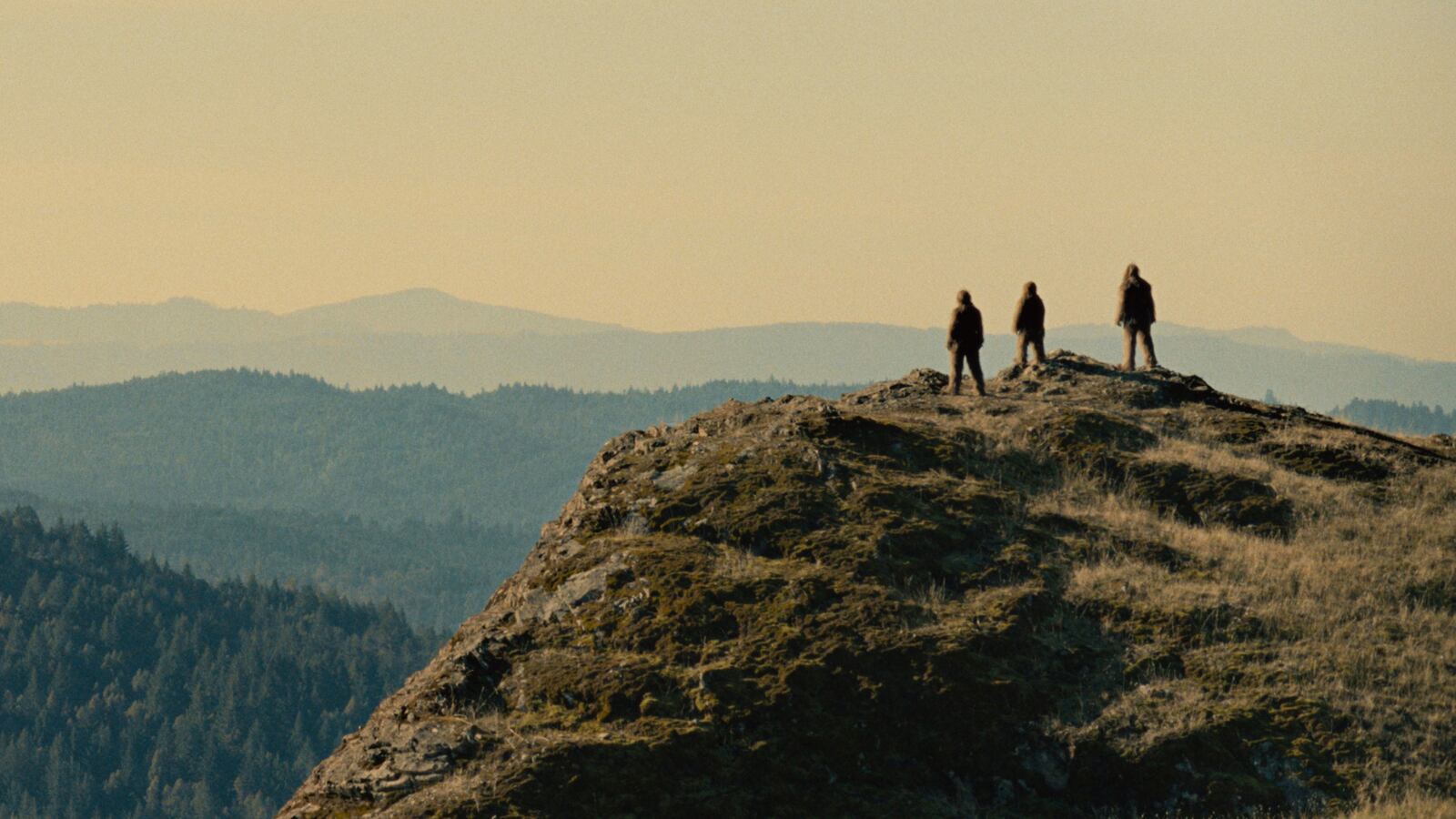Sasquatch Sunset’s reputation precedes it—perhaps for better and worse. Now in theaters nationwide, the unique film follows a family of Bigfoots (Bigfeet?) through one year in the wild, as they experience the triumphs and tribulations of cryptid life. It’s a harrowing tale, packed with death, danger, and even sexual assault. But it also shows these grunting, furry creatures copulating, pissing, and shitting.
Early reviews out of the film’s Sundance premiere in January largely referenced these raunchier elements in characterizing the film. The film was a “crowd-upsetter” that numerous people walked out of; it landed “somewhere between poignant and Sas-scatological;” its appeal is predicated on “your tolerance for slapstick humor,” with the film “seemingly hung up on all manner of bodily functions.” (The Daily Beast’s Obsessed referred to the film as “disturbing Sundance” with its “pooping, pissing Bigfoots.”) Underneath the grotesqueries, many critics noted, was a story about the importance of family and the fight for survival. But much like the chatter around it, it’s hard to get to the heart of Sasquatch Sunset without trudging through the cowpie-smelling muck and mire too.
The film’s cast and crew, for their part, seems unsurprised by the fixation on their film’s more alienating—or, depending on your taste level, hilarious—elements.
“It was interesting that some of the press at Sundance [responded] very positively, but they were kind of fixated on the scatological stuff,” said writer and co-director David Zellner, in an interview following the film’s screening during this year’s South by Southwest. “And then when we’re in Berlin [for the Berlinale], it was a little more on some of the other themes. We’ve [also] had several women that had just recently had babies that really identified with elements of it, which was interesting. It’s all valid.”
Aiding these separate reads is that the film’s four-part structure ups the ante, ingratiating the viewer with the ways of the Sasquatch. By the end, we share their fear and their elation at every turn—particularly that of the sole woman in the bunch (and arguable main character), played by Riley Keough. In fact, the film is at its most moving and coherent when focused on her. Her troubled pregnancy propels the film forward, and it’s her maternal instincts that keep her and her children, including a baby Bigfoot who is probably the least-adorable infant you’ll ever see, alive through the terrifying dead of winter.
Ensuring that the film had this more serious narrative compared to its inherently absurd premise was crucial, said Nathan Zellner, co-director and co-star (and David’s brother).

Nathan Zellner, Jesse Eisenberg, Christophe Zajac-Denek, and David Zellner attend the Sasquatch Sunset New York Premiere at Metrograph, April 1, 2024.
Theo Wargo/Getty Images“We bring people in with the comedy,” he said. “This could easily be just a one-note kind of film, where it’s just jokes, and it would get old very quickly. But I think in order to have that drama and have that connection, you have to up the stakes at certain points.”
Doing this required killing off Nathan’s own Sasquatch fairly quickly, funnily enough. “Having [the other Bigfoots] be reliant on the Alpha character, and then suddenly getting rid of him, certainly puts all the other three characters in a different, dramatic situation.”
Another quirk of the film is how the characters communicate their concern: exclusively through grunts. There are zero discernible pieces of dialogue in Sasquatch Sunset, contributing to the film’s strangely authentic, even voyeuristic quality.
“The script would say things like, ‘The alpha shrieks or barks’—words to indicate what we would sound like,” says co-star Jesse Eisenberg, whose character becomes the new man of the family after Nathan’s Alpha dies. (“The Alpha was written for me,” he jokes about his subordinate role, “but when I read the script, it just felt like it would be too obvious.”) “We created a vocabulary of what sounds would go where and indicate certain behaviors.”
Eisenberg also brought on a movement coach to help the cast nail down the primal physicality, which, combined with the incredible makeup, helped them transform into their mythical characters to an almost unsettling degree. Well, for the viewer, at least; to the people involved with the project, getting to play these uninhibited simians was a liberating delight.
“We all were just hysterical when we were coming up with these ideas [of how to perform the characters],” said Christophe Zajac-Denek, who plays the littlest Bigfoot, “because it was just so much fun and it was just such a free creative experience for us to try and embody these characters in the most real way possible.”
“The most real way possible” is, of course, some serious irony. But Sasquatch Sunset fancies itself more akin to a documentary than a purely fictional film. Yet one obvious absence is the Bigfoot’s closest relative: we humans. There’s a scene in which the family invades the remains of a picnic, including checking out an abandoned boombox—obvious signs of human life. And in the film’s final moments, Keough and Zajac-Denek’s Bigfoots arrive at a real-life Sasquatch museum at Willow Creek, which is known for the largest number of alleged Bigfoot sightings in the country. But we never see a human on screen. Perhaps it’s because, as the Zellners note, such an interaction might actually be far more disturbing and odd than watching these Bigfoots traverse nature in all their great and gross glory.
“With other movies, with Bigfoot or any otherworldly type of creature, [you see it from] the human’s perspective,” says David Zellner. “Whatever this creature is, it’s like the boogeyman or something mysterious. We really wanted to have it reversed where the humans assume that position, where they’re the mysterious alien life form basically that you’re only exposed to to a certain degree.
“You have to piece together what that world is, and that’s much more interesting than if we spelled it all out.”
There’s also a production reason to not show human beings, however, as Nathan pointed out: “Way down on the list of why we didn’t want humans in the movie was so that we wouldn’t break the scale.”

Toto Miranda, Nathan Zellner, Jesse Eisenberg, Christophe Zajac-Denek, David Zellner, Josh Lambert and Yvonne Lambert attend the Sasquatch Sunset New York premiere at Metrograph, April 1, 2024.
Jason Mendez/WireImageHaving met the Zellners, Eisenberg, and Zajac-Denek in person, we can confirm that they are regular human-sized—which means so were their characters. After all, David said, “To [the Sasquatches,] their feet aren’t really that big. That’s how their feet should be. And since everything was from their perspective, their physical form was the reference for everything else,” size-wise. With few recognizable living things to compare to (save for a murderous mountain lion and some squirrels), it’s easier to maintain the illusion that these Bigfoots are truly the oversized creatures we expect them to be.
Based on how some audiences have reacted to the film thus far, one can only imagine how the humans in the film would have reacted, anyway. Plus, there’s the whole thing about these creatures being pure myth—or are they?
“It’s really interesting to think about it as the link between human beings and the animal community,” said Eisenberg, answering the question of where his belief in Sasquatches stands now. “There’s something really lovely about Sasquatches, because they connect us to other species in a pretty interesting way… They represent our connection to nature and other creatures in a mythological—or perhaps not mythological—way.”
“Almost every part of the world has their own version of the Bigfoot myth,” David Zellner added. “There’s dozens of variations of that throughout the world, and there’s centuries-old myths surrounding them, developed independently of one another with no knowledge of the other parts of the world.
“It really speaks to what Jesse was saying,” he continued. “What is it that led [humans] to these stories, whether there's any truth to them or not?”
Zajac-Denek put it most simply. “How can you totally discredit it and not believe?”
If this is what Bigfoots really are like, well, consider the film a training video. It’s also a test of empathy—one which the strongest of viewers will certainly pass, should they power through what is ultimately a challenging film of the most rewarding variety. Besides, all the critics have already warned you about the bodily fluids and functions; you’re better warned than most viewers initially were, allowing you to pay attention to the emotional and harrowing story at Sasquatch Sunset’s center.







